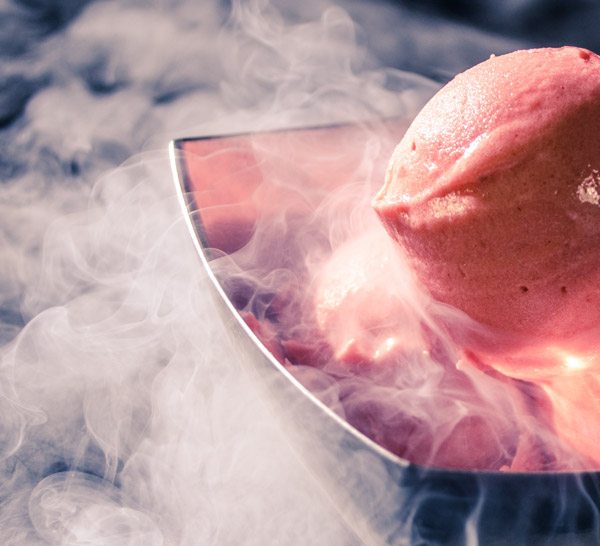
The Vapor of Frozen Dessert Innovation
When most people think of liquid nitrogen, they probably imagine a chemistry lab or a high school science classroom. However, these days, chefs and entrepreneurs around the world are imagining a new setting for liquid nitrogen—the kitchen. Liquid nitrogen is becoming increasingly popular among top chefs who are using this curious, yet natural resource to concoct everything from cocktails to nitro-popcorn. There is no doubt that chefs are pushing culinary boundaries with this new tool, and it is no different in the world of frozen desserts; liquid nitrogen ice cream is emerging from the scene as a new and exciting version of America’s beloved frozen treat.
Ultimately, this new trend is a fairly simple concept: liquid nitrogen is used to freeze an ice cream base, creating a smooth and creamy, almost instant ice cream that is made to order. Liquid nitrogen is a colorless and odorless form of nitrogen gas that is cold enough to exist in liquid form. When combined with an ice cream base, it acts as a freezing agent and creates ice cream in seconds that is smoother than most, thanks to the quick freezing time (the quicker an ice cream freezes, the smaller the ice crystals). Liquid nitrogen ice cream shops make for a thrilling customer experience, being that the vaporous smoke from liquid nitrogen fills the shop with a scientific and futuristic feel as consumers watch their sweet treat being prepared in real time.
Besides being one of the most popular dessert trends of the moment, the liquid nitrogen frozen dessert concept has a few other draws as well. With the growing demand for natural and fresh ingredients, liquid nitrogen ice cream fits right in, needing no preservatives, stabilizers, or emulsifiers to create a rich and flavorful made-to-order product. The liquid nitrogen ice cream process also makes for an extremely customizable cup or cone of ice cream; customers can choose their base (usually a standard base, yogurt base, or sugar-free base), flavor, toppings or mix-ins, and even color. The result is a fresh and creamy cup of ice cream that is customized specifically to each customer’s taste. In addition, the process is so mesmerizing to watch that it is sure to draw a crowd.
So is liquid nitrogen just the next hot dessert trend or is it here to stay? Liquid nitrogen ice cream shops are popping up around the world, some having already been instituted for several years. Established in 2012, Chill-N is a liquid nitrogen ice cream shop in Florida that plays on the scientific nature of the process with a periodic table-themed menu displaying various flavor combinations and possibilities. Niice Cream, a liquid nitrogen ice cream shop in India, also plays on this theme by including a small syringe filled with chocolate topping alongside their desserts. Gimmicks aside, the liquid nitrogen ice cream trend seems to be a viable business model, despite the limited opinion that the process is too labor-intensive and trendy to have any real staying power. However, this notion isn’t stopping the liquid nitrogen trend from consistently gaining more headway in the dessert industry.
Even if the concept of frozen dessert via liquid nitrogen proves to be a fad instead of a long-term trend, it seems as though chefs will continue to innovate and discover new ways to utilize this revolutionary technique in the kitchen.
Whether trend, practical technique, or both, liquid nitrogen ice cream is making waves across the country and around the world. Offering an exciting and innovative process, endless flavor combinations, and a smooth and creamy texture, liquid nitrogen ice cream is definitely worth a closer look, or better yet, a closer taste!
READY TO GET COOL?
Although it sounds like you need to be a mad scientist to make liquid nitrogen ice cream, the process is actually quite simple. Just make sure to take the necessary safety precautions when handling the freezing gas.
What you will need:
- Stand mixer with paddle attachment
- Ice cream base
- Liquid nitrogen (3 times the base volume)
- Toppings or mix-ins
METHOD OF PREPARATION:
- Pour the ice cream base into the bowl of a stand mixer. Mix on medium speed.
- As the ice cream base is mixing, slowly add the liquid nitrogen. Adding the liquid nitrogen too quickly will result in an icy texture.
- Occasionally check to see if the base is freezing evenly. If not, pour the liquid nitrogen even more slowly.
- Continue mixing and adding liquid nitrogen until the ice cream reaches desired consistency.
- Mix in desired flavors or toppings and serve!
Still want to learn more about this trend?
Register for one of PreGel America’s new liquid nitrogen classes at www.pregeltraining.com.
